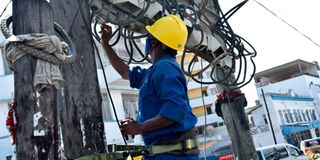Breaking News: Ruto postpones school reopening indefinitely due to flooding
Change model to cut power prices

A Kenya Power employee carries out repairs to a transformer along Haile Selassie Road in Mombasa.
What you need to know:
- Once upon a time, we had an integrated electricity, where Kenya Power and Lighting Company (KPLC) was king.
- In 1997, the World Bank advised us to unbundle the sector by separating the generation side from the distribution and transmission sides.
First, the latest update on the presidential task force on renegotiation of power purchase agreements (PPAs) that Kenya Power has signed with the merchant power plants we call Independent Power Producers (IPPs).
The 16-member committee led by high-profile business executive John Ngumi was sworn in last week at a quiet ceremony held at the offices of the State Corporations Advisory Committee of the Office of the President and attended by members of a special sub-committee of the Cabinet handling the issue.
This is going to be a high-stakes affair because it involves big money. Expect a major pushback by the owners of the merchant plants.
I suggest that this task force conduct its business with more transparency. When you conduct renegotiations involving big money behind the curtains, you open your flanks to allegations of favouritism and dodgy dealings.
Mr Ngumi and his committee must not approach the task before them as if they have solutions to all problems in the electricity sector. Four years ago, a similar task force that was appointed to renegotiate PPAs came up with timid solutions.
This time around, the needle must move. We want to hear about cancellation of licences in the hands of people found to have no capacity to implement the projects and are merely keeping the papers to speculate and to flip third parties at a profit.
Excess expensive power
Can the committee explore the viability of negotiating longer tenures? How about a moratorium on new PPAs? Is postponement of commercial operation dates a viable option? In South Africa, the CEO of Eskom, their equivalent of our Kenya Power, Mr Andre de Ruyter, recently suggested that IPPs look at lowering their financial costs through refinancing. Is that viable?
In response to an article I did in this column, the former CEO of KenGen, Mr Eddy Njoroge, put out a widely published op-ed where he argues that Kenya does not have excess power. The centrepiece of his argument was summarised in the phrase ‘the most expensive energy is no energy’, which is the same thing as saying having expensive energy is better than having none at all.
The problem is excess expensive power. We dished out too many PPAs to merchant plants — without regard to our least-cost development plan — and ended up with an electricity system with too much expensive power. All power agreements have ‘take or pay clauses’ that prescribe capacity charges, which means that the off-taker is under obligation to pay the merchants even where the power they have produced has not been consumed.
Under the IPP model that we follow today, every power plant that comes on board brings its own revenue requirements. That means Kenya Power must apply for a tariff increase whenever a new plant comes into operation. Since we have signed too many of these agreements within a very short period, the system has witnessed an unsustainable build-up in payments for unused electricity.
We have 34 PPAs that have been signed and issued to the merchant power plants. Of these, Malindi Solar (40 megawatts), Eldosol Solar (40 MW), Selenkei Solar (40) and Kipeto Wind (100 MW) are ready to roll, having served Kenya Power with commercial operation dates.
Let me now tackle ‘the most expensive power is no power’ theory. To appreciate why this thinking is entrenched in policy-making in the electricity sector, you have to go back to history.
Most expensive power
Once upon a time, we had an integrated electricity, where Kenya Power and Lighting Company (KPLC) was king, controlling everything from distribution to transmission and generation. In 1997, the World Bank came to town and advised us to unbundle the sector by separating the generation side from the distribution and transmission sides and to allow the entry of merchant power plants.
In my view, ‘the most expensive power is no power’ mind-set originated from the Washington Consensus. Power to the people was put on the back burner as policy started emphasising ‘security’ over affordable power to the people.
That transition came with the rise to the top of policy-making of an aristocracy of technocrats who think alike, live in an ivory tower and are out of sync with the reality of the energy poverty in this society.
The Last Mile Connectivity programme was one of the most transformational ones to be undertaken by the government. But haven’t you had members of this very elite advancing the snobbish stiff upper-lip argument that the programme was wrong-headed because all it did was to connect lumpens living in grass-thatched houses in rural areas, where there is not enough demand for electricity?
In this world view, capacity and ability to consume expensive power is what matters. This is a conspiracy to keep our people in the dark ages, if you ask me.
We must accept that the experiment we have been having with the IPP model has failed to give us affordable power.





